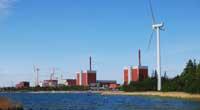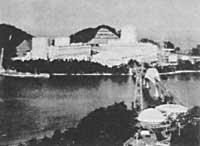Nuclear in crisis
2009/10/30 Galarraga Aiestaran, Ana - Elhuyar Zientzia
Just one year has passed since the International Energy Agency proposed to increase the capacity of nuclear power plants by 80% by 2030. According to the Agency, the goal of the Intergovernmental Organization on Climate Change (IPCC) was to ensure that the concentration of carbon dioxide in the atmosphere does not exceed 450 ppm. In fact, last year's record was 387 ppm, estimating year-on-year growth of 2.1 ppm. Therefore, if no action is taken, there would be a risk of exceeding this limit in less than 30 years.

Two Finnish nuclear reactors from the Olkiluto, to the left of the image is the new reactor during the construction phase. He is now standing. (Photo: Callerna)
It seems that the International Energy Agency made a proposal to avoid it. However, it was not easy to carry out, since an increase in capacity of 80% involves the commissioning of 25 reactors a year, from this year to 2030.
However, the environment was favorable and last year new nuclear power plants such as France, Britain, the United States, China, Finland, Russia, Morocco, etc. were planned. But almost all plans are paralyzed. Reason: they don't have enough money. Or so, "Wall Street doesn't like nuclear power," Arjun Makhijani, president of the Energy and Environmental Research Institute, told the American weekly The Nation.
In fact, the construction of nuclear power plants is very expensive and to be profitable they have to spend years. And, of course, these are not the best times to undertake long-term investments. This will affect not only the greenhouse effect or climate change, but also the weight of nuclear energy on others.
In fact, some experts believe that the industry will not be able to replace aging units. For example, Mycle Scheneider, a nuclear energy advisor, believes that there is a lack of specialized personnel. According to him, the resurrection of nuclear energy is a "myth".
Cases in China and Finland
However, in all countries the situation is not the same. For example, China has maintained its project to build new power plants. According to the data provided by the scientific journal Nature, the Chinese government aims to quadruple its current capacity. Thus, by 2020 it would have installed 40 gigawatts. This year eight nuclear power plants have begun to be built in the world, of which six are in China (the other two are in Russia and Korea).
But it is not as much as it seems. Schenider and researcher Antony Probgatt, in the article published on the Chinadialogue website, provide other data: In early 2008, only 11 reactors were operating in China, which produced 1.9% of the electricity generated in the country (2.2% in 2003). Of the other countries with nuclear power plants, China is the lowest percentage. Thus, China's projection has no credibility for the International Energy Agency.
The clearest example of the decline in nuclear energy is the new Finnish Olkiluoto reactor. At the moment, Finland has four reactors that produce almost 30% of the electricity generated in the country. In addition, they wanted to make another reactor. But the project is paralyzed by funding problems.
Specifically, it is costing three times more than they initially calculated and the delay is increasing. Finally, the construction company and the developer (Areva de Francia and the Finnish group TVO) have asked for large compensation and, meanwhile, have abandoned the construction of the new Olkiluto reactor.
Continue...(?)
Published in Gara

Gai honi buruzko eduki gehiago
Elhuyarrek garatutako teknologia




